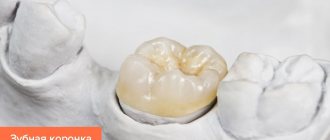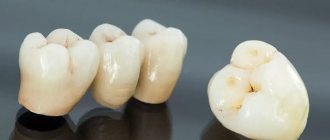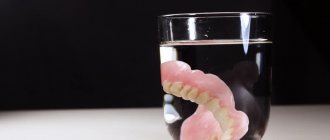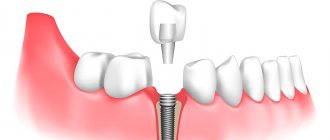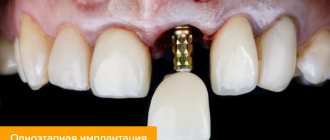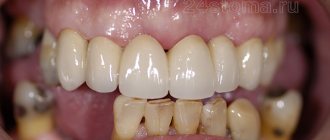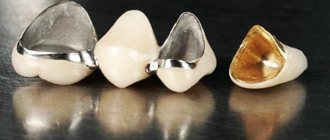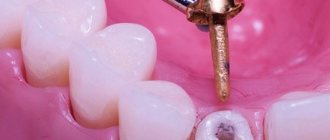June 15, 2019
Many patients are interested in the question of how to remove a crown from a tooth, because essentially the structure is permanent. However, this just means that the owner himself cannot remove it from the mouth, but the dentist, using tools and specialized equipment, will do this without difficulty. Today you will learn about how this process goes, by what methods the final result is achieved, what nuances await patients during the procedure of removing a crown from a tooth from an article prepared by journalists from the editorial office of the UltraSmile.ru portal.
What are the ways to remove a crown?
When is it necessary to remove a crown from a tooth?
Removing the crown from a tooth needs to be done only when there is a serious need for it, because the crown itself can be used for 7-10 years or more (the time period depends on the material from which the prosthesis was made).
Let us list the reasons why it is necessary to resort to such manipulation:
- a disease has developed under the structure: for example, secondary caries, periodontitis or a cyst,
- errors made at one of the stages of prosthetics: perhaps the crown does not correspond to the individual characteristics of the patient, is poorly installed and adjusted, is made of low-quality materials,
- the patient’s desire to replace the structure with a prosthesis made of a better and more beautiful material: for example, replace a metal or metal-plastic product with metal ceramics or zirconium dioxide,
- injuries that led to damage and breakage of an artificial tooth,
- destruction of permanent cement on which the orthopedic structure was fixed,
- The product has expired.
The reason for removal may be the development of caries under the crown.
If the tooth under the crown hurts, there is a bad smell, and the structure has become shaky and movable, then it is time to visit a dentist, who, based on an examination and x-ray, will decide on the need to remove and replace the artificial material.
According to numerous studies, the need to prematurely remove crowns already in the first years of use in 40% of all cases arises due to the fact that poor-quality endodontic treatment and poor-quality sanitation of the oral cavity were performed before preparing for prosthetics.
All of the above reasons are a serious reason to think about removing the prosthetic structure. Naturally, first you need to go to an appointment with a dentist, who will explain how crowns are removed from teeth. And we will look at the methods that exist today.
Treatment
Any type of crown has its own service life, so it is necessary to look at the problem sensibly when pain under a structure made of metal by stamping occurs after 13-17 years of regular wear.
This means that you should not place your hopes on the fact that over all these years the tooth under the microprosthesis has remained healthy and will not bother its owner.
The situation changes if the tooth under the structure “alarms” immediately after prosthetics
It is important to recognize the true cause of what is happening here.
Identifying the problem on your own is quite problematic, so you should completely rely on the integrity and professionalism of your dentist. He will conduct a consultation, prescribe pictures of the jaw and identify the provocateur of painful sensations.
An experienced dentist will find the causative factors of pain and draw up a treatment plan for the unit. In an extremely critical situation, the damaged bone organ is removed, and a secondary prosthetic plan is drawn up according to a new scheme using updated data.
The most optimal method of therapy before treatment and preventive measures to improve the health of the oral cavity involves removing the crown. However, it is unwise to reinstall the same structure, since when removed it is subject to irreversible deformation.
Today, doctors everywhere use a number of methods to relieve the patient of pain under the dental structure without removing it.
Treatment of a living tooth
In such a situation, the pain syndrome is acute. The unit reacts painfully to hot and cold exposure. This indicates the presence of a carious lesion.
The specialist drills a hole in the structure and removes damaged tissue. An artificial hole is made on the chewing side of the tooth, and after treatment it is filled with filling material.
Treatment of a tooth without a nerve
If the unit was previously depulped, the patient will experience aching pain accompanied by pulsation in the temporal region and ear.
This condition is diagnosed as chronic periodontitis (long-term inflammation of periodontal tissues due to infection). Treatment methods are determined depending on the presence or absence of a pin in the root canal:
- The canal is closed only with a filling.
The doctor opens the crown, removes the filling material from the canal and cleans it. Next, the tooth cavity is filled with the drug. This procedure usually requires several visits to the doctor. As soon as the signs of inflammation completely disappear, the dental unit is filled. - A pin is installed in the channel.
Under such circumstances, treatment of periodontitis is carried out using apicoectomy (surgery to remove the apex of the root). This is the only effective technique in this case, which involves amputation of the affected area of the root with subsequent blocking of the infectious process. A simple surgical procedure is performed through an incision in the gum tissue.
Inflammation of the gums around the denture
This painful manifestation is often caused by deformation of the microprosthesis or its incorrect installation.
In such cases, a specialist will temporarily eliminate the symptoms. After some time, the pain returns again, so the denture will have to be removed and the tooth may need to be removed.
Is it possible to install ceramic crowns on chewing teeth, and what is the service life of the products?
In this article we will tell you when it is indicated to install an inlay in a tooth under a crown.
Here https://www.vash-dentist.ru/protezirovanie/nesemnyie-p/viniryi-np/kompozitnyie-foto-do-i-posle-ih-ustanovki-plyusyi-tsenyi.html we offer detailed information about dental restoration with composite veneers .
Method No. 1: sawing with a boron
So, let's figure out whether it is possible to remove a crown with permanent cement.
The method of removal using boron is the oldest and by far the most unaesthetic. This means that after using this tool, the sawn artificial material will only have to be thrown into the trash bin, because it can no longer be used for its intended purpose, that is, it will no longer be possible to re-prosthetize a tooth with it.
The technique is simple, cheap and quite effective, but it must be used by a doctor who has a high level of professionalism, because the approach requires caution and precision. An inexperienced specialist may damage the tooth itself or the soft tissue around it during the dismantling process.
With this method, it will not be possible to reuse the crown
“We removed the crown from the tooth with a regular bur and simply sawed it in half. There’s nothing terrible, but when the material got very hot, the smell, I’ll tell you, was not very good, plus there were slightly painful and uncomfortable sensations, even despite the fact that I had been given anesthesia before this, and the tooth itself had been under the prosthesis for a long time depulped!"
Mari, review from 32top.ru
This method is used if the patient has dentures made of inexpensive materials, which he would not mind disposing of later. The method is also suitable if the artificial structure itself is mobile or wobbly. Then it is simply sawed to the teeth, then, using special tools, the resulting edges are carefully bent in different directions and removed.
Technique for predictable removal of cemented implant-supported dentures
Show menu
- Lectures
- Conferences
- Courses
- Publications/Scientific work
- Abstracts of foreign articles
Abstract compiled by: Abstract compiled by: Bisyaev G.K.
Schweitzer DM, Berg RW, Mancia GO. A technique for retrieval of cement-retained implant-supported prostheses // J Prosthet Dent., 2011.-Vol.106(2).-P.134-8.
The ability to remove prostheses is an important aspect of treatment due to potentially unpredictable biological or mechanical complications. Cement-retained implant-supported dentures with predictable removability increase the clinician's ability to care for, repair, and, if necessary, replace these dentures. The procedure can be performed on either custom abutments or factory abutments for single or bridge restorations. This technique requires metal at the interface between the abutment and the crown and involves the use of a flathead screwdriver to facilitate removal of the prosthesis.
Technique. Make a model of self-polymerizing acrylic resin for a castable screw-retained abutment, with the ideal dimensions of the prepared tooth (Fig. 1). Make a lingual-palatal shoulder approximately 1 mm above the gingiva and follow the contour of the gingival margin (Fig. 2). Mill the lingual-palatal groove in the abutment (Fig. 3).
Prepare a slot at least 1 mm deep and 3 mm wide (mesiodistal), creating enough space to insert the functional tip of a flathead screwdriver to be used for removal (Figure 4). Pack and cast a custom type 4 gold alloy abutment. After unpacking and cleaning, mill the custom abutment to the ideal size and shape using a milling machine, then sand and polish it. Make a substructure of self-polymerizing resin over the custom abutment with a minimum thickness of 0.5 mm. Heat the functional tip of the screwdriver over a fire and place it within the light wax along the length of the abutment arm. Apply pressure until it contacts the axial wall of the milled abutment (Figure 5), creating an open crown edge that is approximately the size of a screwdriver (Figure 6).
Clean, pack and cast gold alloy wax modeling for cermets. Immediately after casting, unpack and process the frame. Apply ceramic as usual. After fitting, fitting and final polishing, secure the denture intraorally with cement. Remove excess cement from everywhere, including the groove. Fill the groove with resilient composite material (Fig. 7).
To remove the denture, remove (if necessary) excess composite material from the groove using hand tools such as a scaler or probe. Then install a flat-head screwdriver with a torque wrench into the groove, press with your finger and apply a force of 32 Ncm while controlling the force. The cement will break and the prosthesis will be removed (Fig. 8, 9).
Discussion
. The presented technique describes the production of cemented prostheses on implants with predictable removal. The release slot allows the flathead screwdriver, when rotated in the slot, to simultaneously apply force coronally away from the abutment and an apical force onto the abutment sufficient to break the cement and separate the two components. Also, the groove can be placed in the area of the angle of the mesiolingual line of the lateral crowns to improve clinical access. During bridge fabrication, this type of crown removal mechanism can be incorporated into multiple parallel milled abutments with a convergence of 4 to 6 degrees each to allow successful removal of the prosthesis when necessary (Figure 10). To remove the bridge, the grooves can be used one at a time to ultimately destroy the entire cement layer (Fig. 11,12). The use of higher hardness gold-containing alloys for the custom abutment and for the prosthetic framework helps in preventing significant distortion of the groove. These alloys are also more resistant to corrosion and have less potential for local toxicity to the tissue around the implant.
Conclusion. The predictability of removal of cemented implant-retained prostheses is a clinical problem. The presented technique includes a design feature that allows these prostheses to be easily and predictably removed to facilitate required maintenance and repair or replacement of the prosthesis by the physician.
Method No. 2: using ultrasound
Are you wondering how to remove a crown from permanent cement in one of the safest and most innovative ways, and without causing any damage to it? Then ask your dentist if it is possible to use ultrasound in your case. Through impulses, the doctor acts on the cement composition, which gradually cracks. The specialist moves along the “tooth-crown” boundary; under the influence of vibrations, the cement is destroyed.
The product can be removed using ultrasound
The procedure really allows you to remove the structure in its original form, but it has a number of disadvantages. First, ultrasound has a rather gentle effect, so it is not always possible to achieve the goal the first time, and sometimes you have to visit the doctor several times. Secondly, only products that are made from not very dense materials are amenable to hardware exposure to sound waves. For example, it will not be possible to remove structures made using glass ionomers using ultrasound. Third, vibrations may be unpleasant for the patient.
Preliminary consultation and treatment planning
After the patient and specialist determine the type of prosthesis that will be installed, they begin to select the material used for its manufacture.
The most common and popular are metal-ceramic prostheses. You can also make a prosthesis from metal, porcelain or gold. Zirconium ceramics and aluminum oxide are also popular and very durable.
Let's look at the stages of installing dental bridges:
- Examination of teeth and jaw.
- If necessary, treatment of teeth and gums is performed.
- Introduction of anesthesia.
- Preparation of supporting teeth (most often grinding them).
- Casts and x-rays of the opposite row of teeth, as well as supporting teeth.
- Making a model of a prosthesis from plaster and trying it on.
- Choice of crown color. At this stage it is excellent to work with ceramics, since this material allows you to choose the most suitable shade of color.
- Creating a temporary bridge that will protect the teeth from external irritants before making a permanent one.
- Making a permanent bridge.
- Installation and cementation of the prosthesis.
Method No. 4: Kop (Koch) apparatus
This is a tool that again has a hook at the end. However, the device is not launched mechanically, but using a button, which breaks the cement along the edge of the crown using small shocks or a shock wave, after which the structure begins to move from its place. Next, the doctor can only use special forceps that hook and help to finally remove the prosthesis.
See what the Koch apparatus for removing crowns looks like in the photo.
This is what the Koch apparatus for removing crowns looks like
This device is more convenient and efficient than a manual device; it allows you to remove the product with virtually no damage and “works” quickly. However, it also has disadvantages. In particular, many patients note that during the procedures they feel “twitching” and discomfort. Also, some people are very concerned about the noise that the device makes. There is one more drawback - the device can damage the ceramic coating of the crown, leaving chips and cracks, and then the structure will have to be restored.
Select the required service
The procedure is indicated in the following cases:
- It is necessary to restore the crown part of the tooth when it is destroyed by more than 60 percent.
- An unaesthetic appearance, a dental anomaly that cannot be corrected with braces.
- Thinned enamel.
- A bridge prosthesis needs to be installed (crowns are placed on adjacent teeth).
- Fluorosis.
- Chipped tooth due to injury.
Installing a crown will protect the tooth from further destruction or fracture at the gum level. It is possible that an implant will be required before the procedure. This is necessary if the root of a tooth is lost, several teeth are lost in a row, or a row is not formed.
Method No. 5: using the Coronaflex device
The device looks like a pistol, and its operating principle is based on compressed air, which escapes from the device under pressure and breaks the cement. At the same time, this device does not have any negative effect on the artificial material of the structure or on the soft tissues of the patient.
The Coronaflex device is not available in every dentist today, so the procedure with it will be more expensive compared to other methods. However, it makes sense to use the device if you have a zirconium dioxide crown, which can be reinstalled after, for example, the tooth under the structure is cured. In addition, the procedure using this device is more comfortable, safer, and requires less time to solve the problem. Also, according to patient reviews, the device makes virtually no noise, which allows you to feel comfortable in the dentist’s chair.
The Coronaflex device removes the crown quite comfortably
Crown removal methods
You can remove an installed crown using different methods. It all depends on the purpose of dismantling and therapeutic indications.
The method of removing the prosthesis is chosen by the patient himself based on financial circumstances, available time and recommendations of the dentist. The doctor ultimately chooses the method that is most suitable for the patient, depending on the causes and sensitivity of the teeth during repeated intervention.
Copp (Koch) apparatus
This is a special drill that breaks up the cement base with small pushes. The denture begins to slowly move to the side, leaving the tooth area.
Then, using dental forceps and attachments, the prosthesis is picked up and picked out. The method is painless and does not damage the oral cavity as a whole.
This method has a drawback - the device often scratches the ceramic lining of the prosthesis, which requires its restoration.
Coronaflex device
The device is used to preserve the integrity of the crown during subsequent fixation without injury or damage by exposure to compressed air. The orthopedic structure is preserved and removed without damage.
For example, a product made of zirconium dioxide has a high cost, and it is expensive to damage such a product; it is more economical to use the Coronaflex device. The technique is expensive due to the high price of the equipment used.
Ultrasound de-cementation of the crown
Removal by destroying the cement base. Not all materials lend themselves to this method; it all depends on the type of cemented material. The method is not applicable to glass ionomer substances.
Sawing
This is the crudest technique for items made from durable materials, such as ceramics. The cost is not expensive and almost painless, but quite lengthy. When the prosthesis is removed, it is completely destroyed.
This method is used most effectively if a metal-ceramic crown is loose. As a result of such manipulation, subsequent prosthetics with this structure are no longer possible due to its damage.
Therefore, patients should take this fact into account when choosing a material. When metal-ceramic crowns are removed, pre-treatment with ultrasound is most often carried out, which causes cracking of the cement base and makes it possible to easily remove it.
Other methods
Other methods suitable for dismantling orthopedic structures. To remove them, special tools are used that allow you to control the force and direction of the load on tissue covers and prostheses, namely:
- Higa bridge remover;
- crown removers Metallift and Auto Abdicator;
- special purpose forceps;
- tool with a hooked end;
- jackhammer;
- pneumatic tools.
All techniques are performed under local anesthesia, so pain and discomfort are excluded.
Is it possible to remove a crown at home?
If you are interested in the question of how to remove a crown from a tooth at home, then the answer will be clear: you cannot do this at home. This procedure should only be performed by a professional dentist. For those who neglect this rule, everything can end sadly: there is a risk of damaging not only the artificial material, but also injuring the soft tissues and the tooth itself, which is located under the crown.
You can try to remove the structure yourself only if it has come unstuck and started to loosen, or if it has fallen apart or split, and there is a need to remove the remaining fragments of the product, which can injure the mucous membrane or antagonist teeth. But it’s better if you rush to see a dentist even in such situations.
If the structure comes unstuck, you can remove it yourself
If the materials from which the crown was created, as well as the cement, have expired, and you do not rush to the dentist, then an unpleasant situation may await you. For example, artificial material can be swallowed. What to do in such situations, read the material “5 useful tips for those who have swallowed a crown.”
About metal ceramics
Metal-ceramic crowns are prostheses used to restore missing or severely damaged teeth and preserved roots. They consist of two elements: a solid metal frame and an outer part made of ceramic. The base can be made of different metals and alloys, for example, titanium, chromium and nickel, or even gold and palladium. In appearance, a ceramic onlay is practically indistinguishable from a real tooth, as it accurately replicates its color, transparency and texture. The listed properties are selected for each patient individually.
Dental restoration with this prosthetic method is recommended for patients:
- with brittle teeth;
- who have lost more than 50% of their enamel (due to diseases and their consequences);
- with tooth decay that cannot be corrected with conservative methods.
But before choosing this type of prosthetics, pay attention to a few points. Firstly, the tooth on which it is put on needs to be ground down. Secondly, the presence of metal in the structure can lead to the formation of a dark stripe in the gingival area.
Is it possible to cure a tooth without removing the crown?
The question is very relevant, because usually, after removing a structure, it can rarely be reused for its intended purpose, therefore, you have to pay money for the manufacture and installation of a new prosthesis. Fortunately, today in some cases you can do without removing the structure. For example, if it is necessary to cure recurrent caries or remove a small cyst, the doctor may perform endodontic manipulations through a small hole made in the crown or through an incision in the gum (to remove the cyst). After the procedures, this hole will be masked with a composite material, and the sutured gum will need time to heal.
In some cases, modern technologies make it possible to cure a tooth without removing the crown.
However, you need to understand that in order to safely and effectively carry out such jewelry manipulations, the doctor must be a professional. In addition, the patient himself should seek help when the problem is still minor and the inflammatory process has not gone too far. To do this, it is necessary to undergo preventive examinations, because the more minor the problem, the easier it is to solve it with therapeutic methods, without resorting to drastic measures.
Notice
: Undefined variable: post_id in
/home/c/ch75405/public_html/wp-content/themes/UltraSmile/single-item.php
on line
45 Notice
: Undefined variable: full in
/home/c/ch75405/public_html/wp-content /themes/UltraSmile/single-item.php
on line
46
Rate this article:
( 6 ratings, average: 5.00 out of 5)
crown
- Lutskaya I.K., Zinovenko O.G. Frequency of development of caries in teeth covered with artificial crowns.
Indications for removing structures
Fixing a dental crown or bridge, which is fixed on two supporting units (these can be implants), is a slow and quite labor-intensive process. In a good way, a well-installed design and compliance with all the rules of oral care, professional hygiene every six months allow them to remain in their proper place for a long time - 10, 15 years, or even longer. In any case, the reasons for early removal of a crown or bridge must be serious. Let's take a closer look at them.
Only until 15.01 South Korean implant Osstem - from 18,500 rubles.
Hurry up to sign up for a free consultation and lock in promotional prices.
Call now or request a call
Opening hours: 24 hours a day - seven days a week
Pain and destruction of supporting teeth
It happens that a tooth hidden under the cover of a prosthesis begins to bother its owner and hurt. In this case, the person complains not only of pain, but also of an unpleasant putrid odor from the mouth, more precisely, from under the structure (according to science - halitosis). There are several reasons: the root of the covered unit has become infected, caries is progressing, sometimes pulpitis or a cyst has appeared.
If the doctor is unable to reach the site of the lesion, he needs to remove the prosthesis (or the entire bridge structure), that is, completely saw and remove it.
However, you can relieve a person from pain and cure a tooth using a workaround. So, the doctor can drill a hole in the desired area of the crown and perform treatment through it. At the end of the therapeutic measures, the formed cavity is closed with composite materials. But it is important to understand that such a treatment method, which protects the patient from dismantling a non-removable product, shortens the life of the structure. In addition, it cannot always be applied.
Poor installation
It happens that the fixation of orthopedic products was not carried out properly by the doctor. Or, over time, the prosthesis itself has lost its stability. Here are the most common reasons why this can happen:
- mistakes made by an inexperienced doctor when fixing the base of the prosthesis,
- The prosthesis initially does not fit tightly,
- the design of the crown does not coincide with the bite, that is, it causes pain when closing the jaws,
- the cement turned out to be of dubious quality,
- the integrity of the connecting filling layer at the junction points is compromised.
It is not difficult to understand that a crown or bridge is no longer firmly in place. This will be indicated by symptoms such as their staggering, swaying and mobility, especially obvious during a meal or conversation.
Gum problems
Our soft tissues that “cover” the jaw bones can suffer due to various circumstances. The most typical cause is inflammation caused by poor oral hygiene. Caries, damage to the mucous membrane and even prolonged stress1 can cause redness and swelling of the gums (gingivitis). It happens that periodontal tissues are injured due to an unscrupulous approach to the manufacture and installation of the product. If it rubs the free gum, it provokes the development of inflammation. And this is a direct indication for the elimination of the removable structure, and the soft tissues themselves will require therapy.
Violation of aesthetics
It happens that the patient does not have dental indications for removing orthopedic installations. The products do not cause problems to a person, they are intact, without chips or cracks (in the latter case, repairs are sometimes possible, but more often liquidation of the devices is required). And yet, a person still sits in the orthopedic chair in order to dismantle the prostheses. Often this is dictated by the desire to update old structures. It happens that they are subject to deformation and lose their aesthetics. Often we are talking about the desire to replace orthopedic products with more modern, high-quality and durable analogues.
Complex on 4 OSSTEM implants with delayed loading - from RUB 170,000.
Complex implantation Osstem (South Korea) with delayed loading after 4-6 months.
Guarantee for the doctor’s work - unlimited Call now or order a call
Opening hours: 24 hours a day - seven days a week
Comments
Good afternoon. My metal-ceramic bridge on one tooth became movable. It is possible to remove the bridge without damage in order to reuse it. Thank you.
Svetlana (06/18/2019 at 11:25 am) Reply to comment
- Dear Svetlana! As a rule, no, the bridge is completely removed (you need to saw it). In addition, it is fixed on at least 2 supporting teeth, which apparently have become unusable.
Editorial staff of the portal UltraSmile.ru (06/21/2019 at 12:23 pm) Reply to comment
Tell me, how do you remove the crown from the implant?
AlinaR. (06/22/2019 at 17:29) Reply to comment
- Dear Alina! There are two extraction methods here, and which one to use will depend on how the crown is attached to the implant. If the fixation was screw (which is more preferable), then the doctor will simply unscrew the screws connecting the crown, implant and abutment. If the fixation was cement, then the specialist will use the cutting method - others are not suitable for implantation.
Editorial staff of the portal UltraSmile.ru (06/25/2019 at 09:19) Reply to comment
Which doctor should I go to to have my crown removed?
Makar (06/30/2019 at 10:02 pm) Reply to comment
- Dear Makar! This manipulation should be performed by an orthopedic dentist.
Editorial staff of the portal UltraSmile.ru (07/03/2019 at 09:17) Reply to comment
Is this procedure, removing a crown from a tooth, painful?
Arfa (07/18/2019 at 04:47 pm) Reply to comment
- Good afternoon This procedure cannot be called pleasant and comfortable, but it is painless, because... the doctor applies anesthesia. In addition, in most cases, crowns are used to replace already pulpless teeth that do not have a nerve. Pain and discomfort can only occur if inflammation has begun under the crown. Then pain can be felt not only in the tooth itself, but also in the soft tissues surrounding it.
Editorial staff of the portal UltraSmile.ru (07/26/2019 at 09:33) Reply to comment
Will my tooth hurt after the crown is removed?
Vedeneeva Victoria (05.08.2019 at 19:05) Reply to comment
- Dear Victoria. A tooth can only hurt if it has developed periodontitis or granuloma. Less often, pain occurs because the crown removal procedure was carried out by a not very professional doctor, who could injure the gums or mucous membranes, or damage the tooth itself.
Editorial staff of the portal UltraSmile.ru (08.08.2019 at 09:25) Reply to comment
Tell me, what if the crowns do not fit tightly to the gums on the back side, where is the palate? is this normal? that is, the tricrowns on the right entered the cast gums; three crowns _and the other three on the back side I feel their edges with my tongue….
san (01/09/2021 at 04:13) Reply to comment
a metal-ceramic bridge costs 10 months on one side it moves away and sways I was at the doctor’s appointment and the answer was swing the entire bridge and come what to do
Natalia (09.12.2021 at 18:51) Reply to comment
Write your comment Cancel reply
What to do after removing the structure
If the doctor finds an inflammatory process at the site of the removed crown or bridge, therapy will be required in accordance with the cause that caused it (caries, pulpitis, gingivitis, periodontitis, etc.). Accordingly, treatment is first carried out, after which the shape of the tooth is restored, impressions are taken again and a new prosthesis is created (or the old one is returned to its place - if possible).
But it happens that after dismantling the structure, the patient experiences discomfort or even pain. To establish the cause, the doctor needs to carefully examine the tooth and surrounding tissues and assess their condition - this requires an x-ray. It will show the quality of the filled canals and the condition of the structures surrounding the tooth. It happens that the tissues under the crown have changed irreversibly and can no longer be restored. Then repeated prosthetics becomes impossible, the tooth will need to be removed. And you can think about alternatives to prosthetics: installing a bridge or an implant.
- The influence of stress on the condition of the tissues of the maxillofacial area. / Korenevskaya N. A., Gorodetskaya I. V. Journal “Bulletin of Vitebsk State Medical University”. 2009
- Study of the process of removing dentures by destroying the fixing cement under ultrasonic influence. / Kiselev M. G. Vertinskaya A. P. Journal “Science and Technology”. 2007
Author: Chernov A. R. (Thank you for your help in writing the article and the information provided)
Stock
-20%
Manufacturing of removable denture Acry Free 40,000 rub.
32,000 rub.
get -13 %
Metal-free dental crown made of zirconium dioxide 40,000 rub.
35,000 rub.
get -47 %
Dental implantation RUB 18,500.
until 01/15/2022 35,000 rub. 18500 rub.
get -35 %
Metal-ceramic crown 10,000 rub.
6500 rub. get
In what cases is complex tooth extraction required?
- Inability to cure one of the molars.
- Growth of wisdom teeth at an angle.
- Uncut "eights".
- Curved and severely damaged roots.
- Fusion of roots with jaw bones.
There is also such an operation as complex tooth root removal. Sometimes the tooth is completely destroyed from the outside, but the root remains in the jaw and continues to become inflamed and painful. In this case, the dentist cannot simply pull out the tooth with forceps, since there is nothing for it to grab onto. You have to cut the gum and use special tools.
